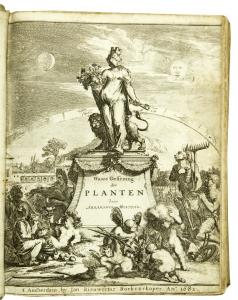Waare oeffening der Planten waar in De rechte Aart, Natuire, en verborgene eigenschappen der Boomen, Heesteren, Kruiden, ende Bloemen, Door een veeljaarige onderzoekinge, zelfs gevonden; Als meede op wat maniere zy, in onze Neder- en Hoog-duitsche Landen, gezaait, geplant, bewaart, ende, door het geheele Jaar, geregeert moeten zijn, kenbaar gemaakt worden.
Eur 1,800 / USD 2,000
The price shown on each item does not include V.A.T (Value Added Tax). As a result of the recent EU legislation we are required to charge our EU customers the percentage of V.A.T. charged by the customer’s country of residence, unless they possess a V.A.T. registration number. Postage Additional.
Amsterdam, Jan Rieuwertsz., 1682. 4to. pp. (40), 656, (20), with engraved frontispiece and 40 engraved plates. Contemporary vellum.
Second edition, first published in 1672. Abraham Munting (1626-1683) was the son of Hendrik Munting, who had founded in 1642 a botanical garden situated within the fortification circuit of Groningen known as the 'Paradise of Groningen', with its hothouses and forcing frames. It was famous throughout Europe and a place of horticultural pilgrimage. His son, Abraham, director of the garden from 1658, greatly enlarged the garden. The 'Waare oeffening der Planten' describes to a large extend trees and plants of the garden. The work was expanded to a folio format adding new text and plates and appeared in Dutch 'Naaukeurige Beschryving der Aardgewassen' in 1696 and Latin 'Phytographia curiosa' 1702. Our copy does not have the last leaf 'Register Eeniger vernaamste Gedenkweerdigheden', present in some copies. The general 'Register' is complete. We have had several copies in the past without the last leaf and the present copy is most likely an early issue.
Provenance: Signature on free endpaper 'Amico M. Slakman, Hugo de Vries Dec. 1932'
Hunt 363; Nissen BBI, 1430; Paradisus Batavus, 40.










